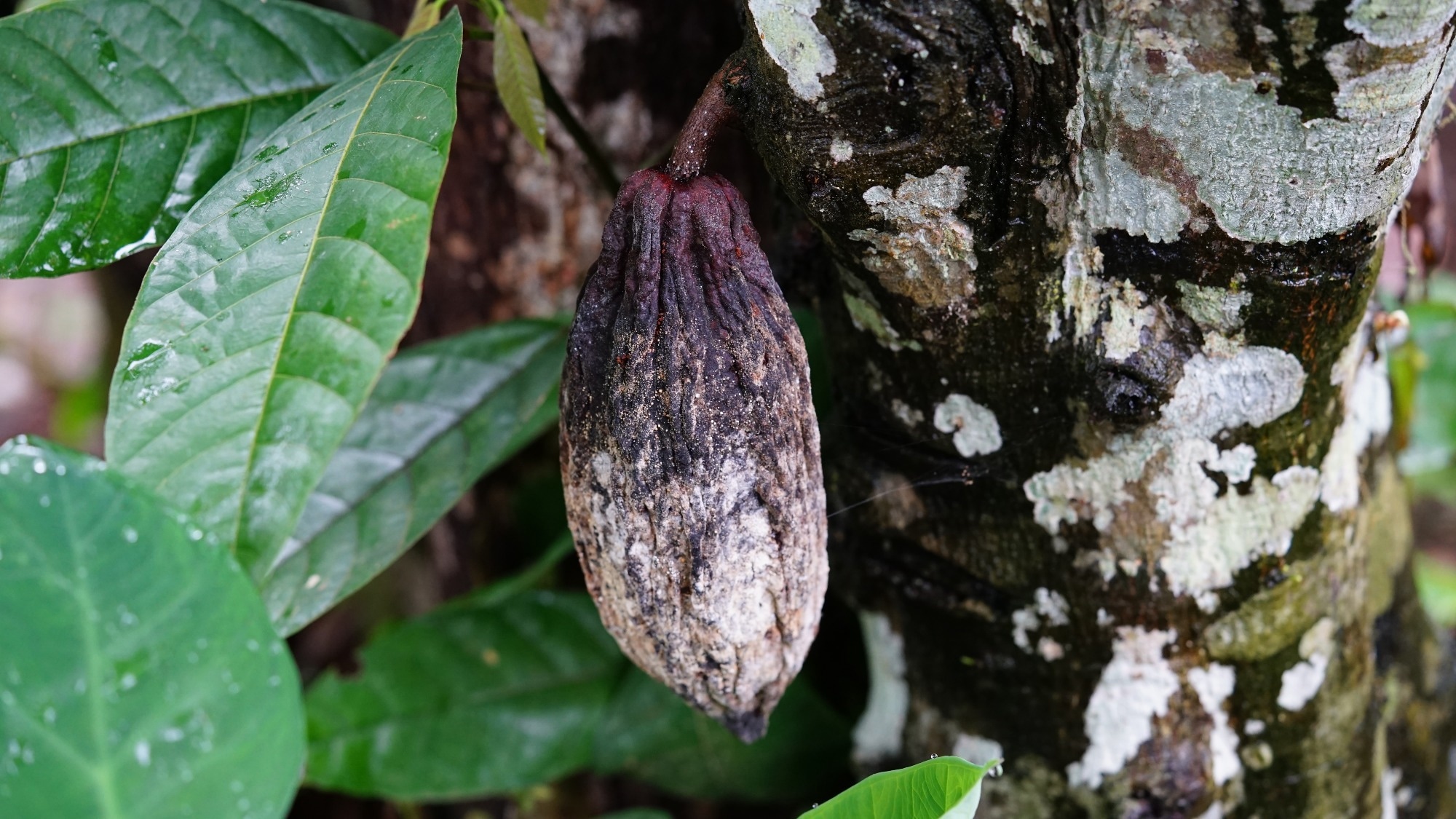 By Pooja Toshniwal PahariaReviewed by Lauren HardakerSep 17 2025
By Pooja Toshniwal PahariaReviewed by Lauren HardakerSep 17 2025In a recent study published in Plant Biotechnology Journal, researchers modified the Theobroma cacao non-expressor of pathogenesis-related 3 (TcNPR3) gene using clustered regularly interspaced short palindromic repeats (CRISPR)-associated protein 9 (Cas9) gene editing.
 Image credit: I Made Rai Yasa/Shutterstock.com
Image credit: I Made Rai Yasa/Shutterstock.com
The edited plants showed reduced susceptibility to the Phytophthora pathogen in laboratory tests, but the study did not measure yield outcomes. The authors emphasize this as an early-stage, greenhouse-based demonstration, with field trials now underway. This work offers a path to potentially higher yields at lower costs with fewer chemicals, supporting sustainable chocolate production.
Global cacao production faces critical challenges as diseases, especially black pod caused by Phytophthora species, drive historically high cocoa prices and record-low stocks. The pathogen severely damages pods, stems, and leaves, threatening the harvests and livelihoods of farmers. While chemical control and sanitation help, their costs are prohibitive for most smallholder farmers.
Standard breeding practices for improving disease tolerance are also slow, and the adoption of improved varieties remains limited. These constraints underscore the urgent need for innovative approaches. Genomic editing could accelerate the development of perennial crops like cacao, which have long generation times, while ensuring sustainability in the face of growing climate pressures.
About The Study
In the present study, researchers utilized CRISPR–Cas9 genome editing to manipulate the NPR3 gene in cacao, which suppresses plant defense. They aimed to improve disease response to Phytophthora by creating edited plants with enhanced immunity without permanently incorporating foreign deoxyribonucleic acid (DNA).
The team developed two transgenic T0 cacao lines (PSU-52 and PSU-67) that carried the CRISPR–Cas9 system, including a binary vector, pGSh16.1010, comprising Cas9 and guide ribonucleic acids (RNAs) specific to TcNPR3. They also generated a control line (PSU-173) with an identical vector without gene-targeting guides. They conducted these experiments in a greenhouse at The Pennsylvania State University.
To obtain non-transgenic progeny plants, the researchers crossed the T0 plants with traditional cacao genotypes (Kerl-L and Scavina-6). They used pollen from T0 plants to fertilize flowers of the recipient genotypes and collected mature pods five months after pollination.
The team screened the seeds for enhanced green fluorescent protein (EGFP) fluorescence and germinated them under controlled greenhouse conditions. They analyzed F1 progeny to identify individuals carrying the desired npr3 mutations but not the transfer DNA (T-DNA), i.e., DNA from the CRISPR–Cas9 vector.
Genomic DNA extracted from the leaves underwent polymerase chain reaction (PCR) amplification. Amplicon sequencing confirmed the presence of targeted mutations, while long-read PacBio sequencing performed on T0 lines confirmed the gene edits.
The researchers used RNA extracted from the leaves to construct transcriptome libraries. Differential expression and functional enrichment analyses characterized transcriptional changes associated with NPR3 disruption. Then, foliar bioassays exposed leaves of edited and control plants to an isolate of Phytophthora palmivora to assess phenotypic outcomes and evaluate plant resilience to infection. After two days, they measured the infected areas on the leaves using digital image analysis.
Results
CRISPR–Cas9 editing of the NPR3 gene successfully produced non-transgenic cacao progeny with enhanced resistance to Phytophthora. Outcrossing transgenic T0 lines with typical genotypes eliminated T-DNA while retaining npr3 mutations. Whole-genome sequencing (WGS) confirmed T-DNA presence in T0 lines and verified their absence in seven F1 progeny, establishing the generation of transgene-free, gene-edited plants.
Foliar bioassays demonstrated a consistent reduction in disease susceptibility. Mutant plants exhibited an average lesion size of 0.92 cm² following Phytophthora inoculation, representing a 42% reduction compared to controls (1.5 cm²). Genome-edited plants were phenotypically indistinguishable from wild-type cacao, showing normal growth and development.
Transcriptome analysis revealed 119 differentially expressed genes (62 upregulated, 57 downregulated) in npr3 mutants in relation to non-transgenic controls. Upregulated genes included chitinase 5, purple acid phosphatase 17, and U-box domain-containing protein 33, enhancing protection against pathogens.
Downregulated genes included Nimin1 and Nimin2, consistent with enhanced pathogenesis-related (PR) gene expression. Genes encoding ferritin were also downregulated, suggesting disruption of iron homeostasis, increased free iron, and enhanced reactive oxygen species (ROS) responses, hallmarks of plant immunity.
Transcript levels of TcNPR3 were reduced by 50% in heterozygous mutants, while TcNPR1, the master regulator of immune response, remained unchanged. The findings indicate that TcNPR3 functions both as a suppressor and partial activator in basal immune transcriptional regulation.
PCR and sequencing revealed novel insertions and deletions in F1 progeny not observed in T0 plants, which the authors interpret as possibly due to continued CRISPR activity during pollen development, though this remains uncertain. All F1 progeny were heterozygous at the TcNPR3 locus due to outcrossing with wild-type parents and exhibited similar reductions in lesional size as T0 plants. The study notes that most F1 progeny were still too young for full pathogen assays at the time of publication.
Conclusions
The study demonstrates that CRISPR-mediated mutagenesis of the TcNPR3 gene effectively reduces cacao vulnerability to Phytophthora infection without compromising plant growth and development.
Generating non-transgenic progeny eliminates many regulatory and adoption barriers associated with conventional transgenic methods. The study approach presents a practical method for integrating gene-edited plants into cacao cultivation for more environmentally responsible production practices.
The authors caution, however, that further field trials are required to validate long-term agronomic performance and confirm whether the greenhouse results translate under natural growing conditions.
Download your PDF copy now!
Journal Reference
Guiltinan, M. J., Landherr, L., Maximova, S. N., DelVecchio, D., Sebastian, A., & Albert, I. (2025). Reduced Susceptibility to Phytophthora in Non-Transgenic Cacao Progeny Through CRISPR–Cas9 Mediated TcNPR3 Mutagenesis. Plant Biotechnology Journal, 1–13. DOI: 10.1111/pbi.70365 https://onlinelibrary.wiley.com/doi/10.1111/pbi.70365